who was Maria Curie

Source
Marie Curie became the first woman to win a Nobel Prize and the first person — man or woman — to win the award twice. With her husband Pierre Curie, Marie's efforts led to the discovery of polonium and radium and, after Pierre's death, the further development of X-rays. The famed scientist died in 1934 of aplastic anemia likely caused by exposure to radiation.
Early Life and Education
Maria Sklodowska, later known as Marie Curie, was born on November 7, 1867, in Warsaw (modern-day Poland). Curie was the youngest of five children, following siblings Zosia, Józef, Bronya and Hela.
Both of Curie’s parents were teachers. Her father, Wladyslaw, was a math and physics instructor. When she was only 10, Curie lost her mother, Bronislawa, to tuberculosis.
As a child, Curie took after her father. She had a bright and curious mind and excelled at school. But despite being a top student in her secondary school, Curie could not attend the male-only University of Warsaw. She instead continued her education in Warsaw's "floating university," a set of underground, informal classes held in secret.
Both Curie and her sister Bronya dreamed of going abroad to earn an official degree, but they lacked the financial resources to pay for more schooling. Undeterred, Curie worked out a deal with her sister: She would work to support Bronya while she was in school, and Bronya would return the favor after she completed her studies.
For roughly five years, Curie worked as a tutor and a governess. She used her spare time to study, reading about physics, chemistry and math.
In 1891, Curie finally made her way to Paris and enrolled at the Sorbonne. She threw herself into her studies, but this dedication had a personal cost: with little money, Curie survived on buttered bread and tea, and her health sometimes suffered because of her poor diet.
Curie completed her master's degree in physics in 1893 and earned another degree in mathematics the following year.
Marriage to Pierre Curie
Marie married French physicist Pierre Curie on July 26, 1895. They were introduced by a colleague of Marie’s after she graduated from Sorbonne University; Marie had received a commission to perform a study on different types of steel and their magnetic properties and needed a lab for her work.
A romance developed between the brilliant pair, and they became a scientific dynamic duo who were completely devoted to one another. At first, Marie and Pierre worked on separate projects. But after Marie discovered radioactivity, Pierre put aside his own work to help her with her research.
Marie suffered a tremendous loss in 1906 when Pierre was killed in Paris after accidentally stepping in front of a horse-drawn wagon. Despite her tremendous grief, she took over his teaching post at the Sorbonne, becoming the institution's first female professor.
In 1911, Curie’s relationship with her husband's former student, Paul Langevin, became public. Curie was derided in the press for breaking up Langevin's marriage, the negativity in part stemming from rising xenophobia in France.
Children
In 1897, Marie and Pierre welcomed a daughter, Irène. The couple had a second daughter, Ève, in 1904.
Irène Joliot-Curie followed in her mother's footsteps, winning the Nobel Prize in Chemistry in 1935. Joliot-Curie shared the honor with her husband, Frédéric Joliot, for their work on the synthesis of new radioactive elements.
In 1937, Ève Curie wrote the first of many biographies devoted to her famous mother, Madame Curie, which became a feature film a few years
Discoveries
Curie discovered radioactivity, and, together with her husband Pierre, the radioactive elements polonium and radium while working with the mineral pitchblende. She also championed the development of X-rays after Pierre's death.
Radioactivity, Polonium and Radium
Fascinated with the work of Henri Becquerel, a French physicist who discovered that uranium casts off rays weaker than the X-rays found by Wilhelm Conrad Röntgen, Curie took his work a few steps further.
Curie conducted her own experiments on uranium rays and discovered that they remained constant, no matter the condition or form of the uranium. The rays, she theorized, came from the element's atomic structure. This revolutionary idea created the field of atomic physics. Curie herself coined the word "radioactivity" to describe the phenomena.
Following Curie’s discovery of radioactivity, she continued her research with her husband Pierre. Working with the mineral pitchblende, the pair discovered a new radioactive element in 1898. They named the element polonium, after Curie's native country of Poland.
They also detected the presence of another radioactive material in the pitchblende and called that radium. In 1902, the Curies announced that they had produced a decigram of pure radium, demonstrating its existence as a unique chemical element.
Development of X-rays
When World War I broke out in 1914, Curie devoted her time and resources to help the cause. She championed the use of portable X-ray machines in the field, and these medical vehicles earned the nickname "Little Curies."
After the war, Curie used her celebrity to advance her research. She traveled to the United States twice — in 1921 and in 1929 — to raise funds to buy radium and to establish a radium research institute in Warsaw.
Conclusion
This woman Maria Curie was a great woman who refused to settle for less. Despite her family barground and financial instability, she always dreamed higher. To the Glory of God, she left something never to forget. If Curie could be this determined, I assure you my fellow Steemians, that we would make it even bigger, only if you determine and focus. Thanks for reading my post @precious98.